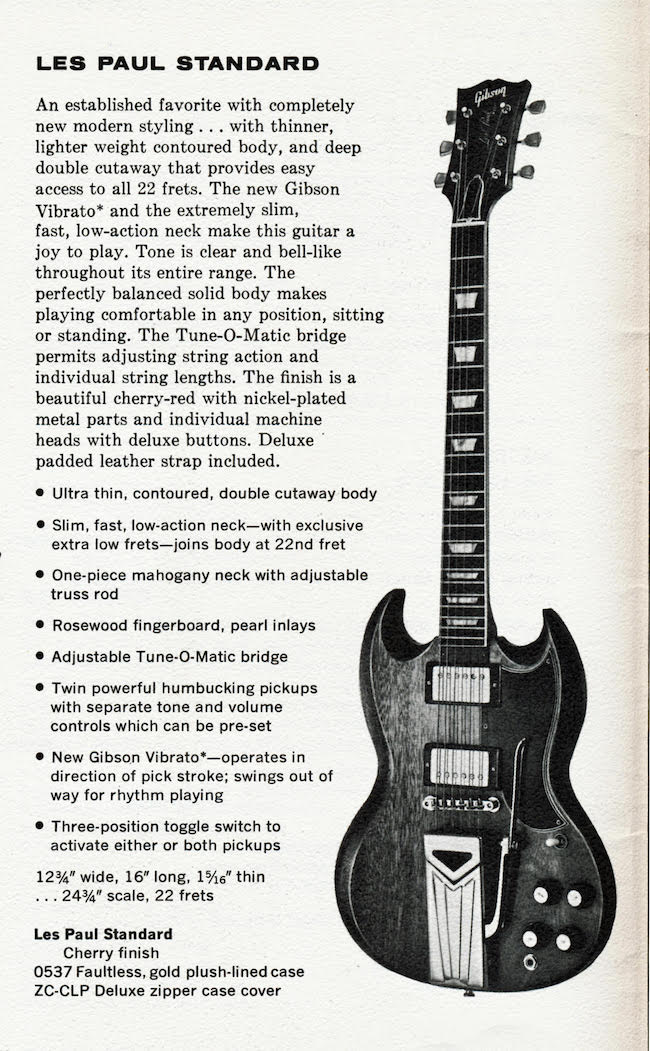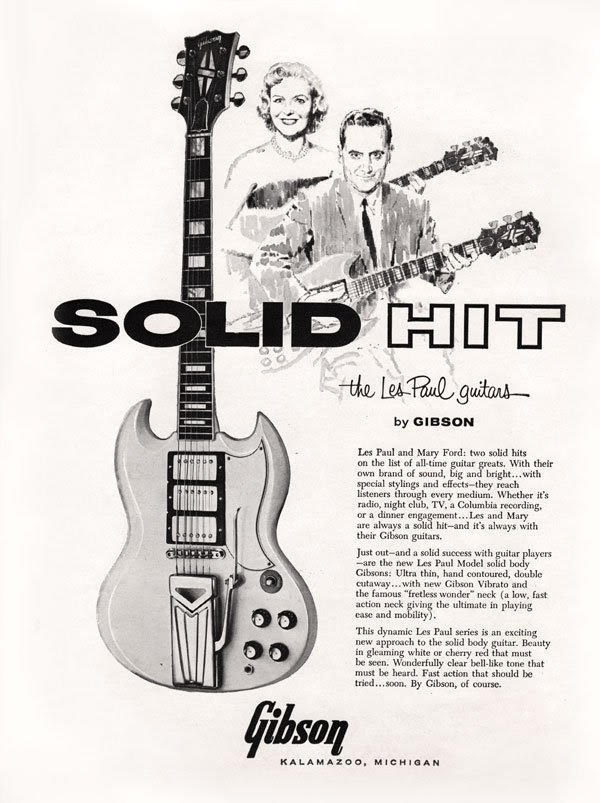If you like traditional single-cut Les Pauls, I suggest you buy one now before they’re all discontinued. Sounds unlikely? That was the position 60 years ago, when Gibson replaced its original-style Les Pauls with the brand new and radical SG design.
It seems unthinkable now. Where would Gibson be today without the born-in-the-'50s Les Paul? Up one of those proverbial creeks with no means of propulsion, probably. Back in 1960, however, the firm’s bosses faced falling sales of the original Les Pauls, after most had peaked the previous year.
Gibson had begun to favor double cutaways for its electric guitars, like the ES-335 and 355 and the special-order double-neck models, all introduced during 1958. Also, the company was reconsidering its endorsement deal with Les Paul. Gibson boss Ted McCarty told me that they started removing Les Paul’s name from guitars in 1959 because Gibson thought the association had become less valuable commercially.
Les Paul had been the perfect choice when Gibson looked for a suitable endorser to promote its new Fender-rivaling solidbody back in 1952. But now his popularity as a recording artist had declined—he’d had no hits since ’55. Gibson figured a change was overdue.
Before we go further with this story of the introduction of the SG design, we need to clear up some confusion that comes from the fact that, despite the big change, Gibson kept the "Les Paul" name for the first few years of the new SG-style models. The nerds among us will know that by late 1963, all Gibson SGs were Gibson SGs. They’ll also know that this followed three broad changes, and it’s the way these changes overlap that causes the confusion.
OK, concentrate now. First came the move of the budget Les Pauls from their original single-cut style to a rounded-double-cut style (not the SG shape). The Les Paul Junior and Les Paul TV moved in ’58, the SG Special in ’59.
Second came the gradual renaming of models from "Les Paul" to "SG." The rounded double-cut Les Paul TV and Les Paul Special were renamed the SG TV and SG Special in ’59. The SG-shape Les Paul Junior, Les Paul Standard, and Les Paul Custom were renamed the SG Junior, SG Standard, and SG Custom late in 1963.
Right, nearly there. The third move was to shift all the Les Paul models to the new SG shape—the Les Paul Standard late in 1960, the Les Paul Custom, Les Paul Junior, SG TV, and SG Special in ’61.
See what I mean? It’s not surprising that players, collectors, and, indeed, some nerds have since simplified this. We now tend to call a Les Paul-shape guitar a Les Paul and an SG-shape guitar an SG. And an SG-shape guitar with the Les Paul name somewhere on it—in other words, one made between late 1960 and late 1963—is often called an SG/Les Paul (or Les Paul/SG). Please don’t feel bad if you want to go back and re-read all that a few times.
Anyway, the good news is that the new model name was quite straightforward—"SG" stood, simply enough, for Solid Guitar. Gibson soaked up plenty of the new trends floating around at the Kalamazoo factory for the SG, including thinner, double-cutaway bodies with full access to the highest frets, new finishes, new pickups (namely humbuckers), and slimmer-profile necks, along with tried-and-tested features and methods from established instruments.
The centre of attention of the new SG design was the striking body, a modernistic departure more like the work of a sculptor than a guitar-maker. The amalgam of bevels and points and angles was made from a solid piece of mahogany, which the firm’s workers turned into a slim, handsome shape, a large cutaway on the bass side and a slightly smaller one on the treble. It was unlike anything any guitar maker had produced before, even if the shadow of Fender was there across some of the ideas.

The horns of the cutaways were shaped to graceful points, and the bevelled edges of around twenty-two degrees sat along the bass side, front and back, inside both cutaways, and along the forward part of the edge of the treble side, front and back, more or less tracing the line of the pickguard. The bevels made the body seem even thinner than it was, and they formed an instantly recognizable, practically useful, and simply attractive feature of the SG design.
The official announcement of the first two new guitars—still for now called the Les Paul Standard and the Les Paul Custom—came in the early months of 1961, although the new Standard began to come off the production line at the very end of ’60.
Gibson mailed its dealers to publicize these "completely redesigned" models. "Here’s an established favorite," said the announcement of the Standard, "now offered with completely new styling… thinner, lighter in weight, and custom contoured. A wonderfully designed solid body, perfectly balanced for playing in a standing position."
The headstock of the new Standard had "Les Paul" inscribed on it, along with a Gibson logo and, below it, a thistle-like ornament. The body and neck were finished in the same cherry red color that Gibson had started to use in 1959 for the double-cut Les Paul Junior and Special and a year earlier for the rear of the Les Paul Standard.
The shortcomings of the separate vibrato tailpiece—which Gibson called a Vibrola and we call a sideways vibrato—soon became apparent, mainly that it often failed to return the strings to correct pitch. The foldable arm was a useful feature—many players fumbled around a while and then stuck the arm out of harm’s way, leaving the vibrato untouched.
For the new Custom, Gibson’s pride was similarly evident: "Players rave about the extra slim neck with the low, smooth frets that is such a joy to play—the action is so easy, players also refer to it as the 'Fretless Wonder.'" The Custom retained its upper-crust qualities, with a new white finish (including the neck), gold-plated metalwork (including the sideways-vibrato’s arm and cover), and three humbuckers.

The Custom’s pickguard matched its white finish, and the same little strip was there between neck pickup and neck, this time marked (for now) "Les Paul Custom." Gibson added its familiar indications of a high-end model: a split-diamond inlay at the headstock, an ebony fingerboard with block pearloid markers, and Grover Rotomatic tuners with metal kidney-bean buttons.
The Custom had the same layout of controls as the Standard, but necessarily wired differently in this three-pickup guitar. The three-way selector offered neck pickup alone (left), bridge and middle pickup together (centre), or bridge pickup alone (right). The two knobs nearest the player were for the neck pickup: volume on the left and tone to the right; the two knobs below were for bridge or bridge-and-middle, depending on the selector position, again with volume on the left and tone to the right. Like some other three-pickup guitars adapting a two-pickup control layout, it was a compromise—once mastered, however, the Custom system offered some pleasing tones.
Three further models with the new SG design, the Les Paul Junior, SG TV, and SG Special, were announced later in ’61 and they sat at the lower end of the SG-design list, with one (Junior, TV) or two (Special) P-90 single-coils. At first, all three came as standard with Gibson’s wrapover stopbar bridge/tailpiece, but there was an option for a separate six-saddle bridge and vibrato tailpiece—Gibson’s simple Maestro Vibrola, with a rounded rectangular frame, curved string mount, and, usually, a name plate.
At the July ’61 NAMM show, Gibson had its full set of new SG-design solidbodies to flaunt: the Les Paul Junior, Standard, and Custom, and the SG TV and Special. As a consequence of the new design, Gibson had dropped the original-design single-cutaway Les Pauls—the sunburst Standard and black Custom—as well as the rounded-double-cutaway cherry Les Paul Junior and Junior 3⁄4, plus the rounded-double-cutaway "limed" SG TV, cherry or cream SG Special, and cherry SG Special 3⁄4.
A late-’64 pricelist showed four models in the SG line, listed as the white SG TV and cherry SG Jr. each listing at $165, the cherry or white SG Special at $240, the cherry SG Standard at $330, and the white SG Custom at $480.
From 1964 until 1967 inclusive, there were no guitars in the Gibson line with the Les Paul name, either on the guitars themselves or in the company’s literature. The original-style Les Paul models had to await rediscovery during the ‘60s before Gibson began to reintroduce them. And the new SG-design models, with various tweaks and adjustments and variations along the way, would prove another popular and longstanding solidbody electric design for Gibson.
An A-to-Z of famous SG users would run from Angus to Zappa, with many, many more along the way—not least Derek Trucks. "The SG is a distinctive instrument," he says. "To me, there are similarities with the slide guitar, where it’s not for everybody and it’s not great in everybody’s hands. It’s a specialized instrument. But if it suits your mind frame, there’s something perfect about it."
About the author: Tony Bacon writes about musical instruments, musicians, and music. He is a co-founder of Backbeat UK and Jawbone Press. His books include The SG Guitar Book, Fuzz & Feedback, and Legendary Guitars: An Illustrated Guide. Tony lives in Bristol, England. More info at tonybacon.co.uk.
